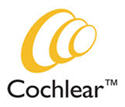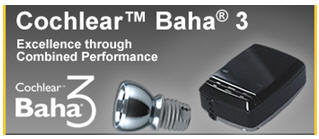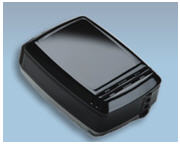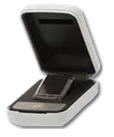Interview with Peter Weber, M.D. & Eric Wilkinson, M.D.
 CAROLYN SMAKA: Today I'm talking with Dr. Peter Weber & Dr. Eric Wilkinson about Cochlear's new Baha 3 System. To start, would you please tell me about your backgrounds and your current roles?
CAROLYN SMAKA: Today I'm talking with Dr. Peter Weber & Dr. Eric Wilkinson about Cochlear's new Baha 3 System. To start, would you please tell me about your backgrounds and your current roles?
PETER WEBER, M.D.: Sure. I am a neurotologist and have been practicing for almost 20 years. I started at the Medical University of South Carolina, then, for the last 10 years I worked at the Cleveland Clinic. I recently joined Cochlear Americas as Chief Medical Officer, and I continue to practice clinically at the Rocky Mountain Ear Center with Dr. David Kelsall.
Peter Weber, M.D.
SMAKA: Dr. Wilkinson, you're at the House Clinic?
ERIC WILKINSON, M.D.: Yes. I'm an otolaryngologist. I did my residency in Iowa and then came out to House Clinic and did my fellowship here in neurotology. My practice is limited to otology and neurotology, and I regularly do osseointegrated auditory implants including the Baha.
Eric Wilkinson, M.D.
SMAKA: Thank you. I'd like to start with some questions about the Baha 3 System for Dr. Weber, and then ask Dr. Wilkinson about his experience with the Baha 3 Implant.
Dr. Weber, can you review general candidacy for an osseointegrated auditory implant? Which patients should audiologists consider referring for a Baha evaluation to see if they are candidates?
WEBER: The Baha is indicated for patients who have single-sided deafness, meaning they have one non-functioning ear but normal hearing in the opposite ear. It is also for patients who have a conductive or mixed hearing loss and a hearing aid cannot adequately overcome the loss, or the patient cannot wear a hearing aid due to chronic drainage, allergies to the earmold material, etc.
It is also very appropriate for children, particularly for children with atresia or other congenital abnormalities that have a normal cochlea but who cannot wear a regular hearing aid. For those children, they start off by using a Softband to hold the sound processor to the skull. We wait to do the surgical implant until the child is five years of age or older, when the skull will have developed enough bone for osseointegration to occur. The Baha carries the same indications for children as for adults, conductive or mixed hearing loss as well as single-sided deafness.
SMAKA: Thanks for that overview. What makes the Baha 3 System different from the previous Baha?
The Cochlear Baha 3 System includes the new Baha 3 Implant (BI300) and the Baha 3 Sound Processor (BP100).
WEBER: The new Baha 3 System includes both, the new Baha 3 Implant, the BI300 Implant, as well as the Baha 3 Sound Processor. The Baha 3 System is exciting for many reasons.
First of all, the implant is designed for improved stability. The titanium fixture that is implanted into the skull is slightly wider than the previous version (4.5mm compared to 3.75mm), which gives it more stability. Also, the surface of the implant has been blasted in order to create a rough surface, which allows for enhanced osseointegration with the bone as compared to implants with a smoother, machined surface. This design works well to keep dental implants stable, and our goal is that this new technology improves the stability of the Baha implant as well.
In addition, the Baha abutments have a conical shape. This gentle curve provides more soft tissue contact and creates a smaller angle;in this way it is designed to restrict upper movement of soft tissue around the abutment. This provides more soft tissue clearance around the abutment.
The Baha 3 implant and abutment interface is a locking mechanism for a tighter fit. The abutment screw will not engage the implant unless it's sitting exactly the way it should. At the connection point, the abutment and the implant also have a new, tighter connection, which is designed to reduce micro leakage and to prevent fluid or debris getting into the implant. These improvements are engineered to deliver consistent results over the life of the implant.
SMAKA: You've mentioned these improvements were designed for enhanced osseointegration - can you explain what that means?
WEBER: Yes. Osseointegration is the process where the implant bonds with the surrounding bone tissue. Our goal is to have the bone grow into the implant so that the implant essentially becomes part of the bone.
The new design of the Baha 3 implant helps seal the fixture into the bone. A recent study indicated that the new Baha 3 implant is 90% more stable than our previous implant.
SMAKA: Up to this point we've been talking about improvements to the implant. What is new with the Baha 3 Sound Processor?
WEBER: The Baha 3 Sound Processor is fully programmable and has many enhanced features. It is fully Softband compatible, provides more water protection than ever before, and the buttons have been improved for better tactile response. The factory settings have also changed to make it easier for audiologists to demonstrate it straight out of box for patients. The Baha 3 Sound Processor has Gore-Tex™ over the microphone so that wind noise is less noticeable. There are new, optional battery doors in new colors. As you can see, we have really enhanced just about every aspect of the processor.
Cochlear™ Baha® 3 Sound Processor (BP100)
SMAKA: Is the new processor backwards compatible for people who may have already been implanted?
WEBER: Absolutely. Most patients that have been implanted in the past that have older sound processors can upgrade to the Baha 3 Sound Processor. Patients who have a more significant hearing loss may need to stay with a higher gain sound processor model.
The new Baha 3 Sound Processor (BP100) is preconfigured to meet the hearing loss profiles
for many patients - demonstrating it in the office is as simple as attaching it and turning it on.
SMAKA: What feedback have you heard from surgeons regarding the Baha 3 Implant?
WEBER: The surgeons who have implanted it have really like the simplified process. The drill that is used to make the hole where the implant is placed has been enhanced to make the surgical process easier and more precise. With the new drill, surgeons know exactly the depth to go when they are drilling the hole in order to place the implant.
We've also created a larger healing cap. This is what keeps the postoperative dressing in place. The larger version reduces the disruption of the material that is used postoperatively to cover the abutment site.
Surgeons have reported that all of these features have made the surgery process smoother and more efficient.
SMAKA: Thank you, Dr. Weber. Dr. Wilkinson, what are the biggest patient indicators for a Baha in your practice?
WILKINSON: We treat conductive hearing losses, atresia, and chronic otitis media with the Baha, but primarily our biggest indication for adults is single-sided deafness.
Initially, the Baha was primarily reserved for atresia in kids;however, because of osseointegrated implants, I think single-sided deafness treatment is becoming more widespread. With children, it depends on the insurance coverage, how the parents feel about it, and how much they want to intervene. For many years, with single-sided deafness in children, we really did not intervene more than giving them preferential seating in the classroom, but that is starting to change.
SMAKA: Certainly the research on children with single-sided deafness shows that many of them have academic difficulties.
WILKINSON: Yes. There is some thought about letting children decide what they want to do as they get older. However, in early childhood when school performance and learning in noisy classrooms are an issue, waiting may not always be the best option. FM systems are great, but if you can give children all-day benefit, that may be better in some cases. We're starting to see some public insurances for children cover the Baha, just as they are now covering bilateral cochlear implants.
SMAKA: What are the etiologies of your patients with single-sided deafness?
WILKINSON: Most are idiopathic, but others include post-acoustic neuroma, Meniere's with very poor hearing and poor speech discrimination, among others.
SMAKA: Dr. Wilkinson, what is a typical osseointegrated auditory implant surgery like, and how does the Baha 3 make it different?
WILKINSON: In terms of the surgery, the procedure has evolved over the last several years. When it was originally designed in Sweden, the initial technique was to use a dermatome to take a skin graft, debulk the soft tissue underneath the skin and around the skin graft site to the level of the pericranium, which is the soft tissue covering of the skull, and then to lift a small flap and place the implant. Recently, in the Netherlands, they started using a vertical linear incision that basically eliminates the skin graft.
Generally, when you do a split-thickness skin graft, you lose all the hair follicles, which results in hair loss around the area of the skin graft. With a vertical incision, we are able to preserve some of the hair follicles, so there is some hair growth up to the level of the incision. The new technique also allows for a little bit faster healing, and it may cut down on irritation.
A study came out this year that looked at the relative efficacy or superiority of four different techniques: a standard dermatome with a split-thickness graft;a full-thickness skin graft which is a little bit of a thicker graft;a U-shaped skin flap using a scalpel to hand create it;and a vertical incision. They found that the vertical incision was superior in terms of skin complications down the road.
The new Baha 3 implant further improves the surgical process, because it simplifies the procedure when we stage it. For example, in children, we'll often do a two-stage surgery where we put an implant under the skin initially. We close the skin over the implant for a few months to allow the bone to integrate with the implant. Then, we make an incision to attach the abutment for the processor to attach to. By doing a staged procedure, you improve your chances of good osseointegration for children with thin skulls, like those with Treacher Collins, and prevent failure over the long-term.
The Baha 3 implant drill is now designed to be able to put an implant in for a staged procedure without needing to have a fixture mount on the top of it. Before, we put in an implant with a fixture mount, a two-piece device, and then actually unscrewed the fixture mount part off and closed the skin. With the Baha 3 implant, you can insert the implant without needing to remove the upper parts. This allows for a simpler insertion with less hardware.
As Dr. Weber mentioned, another advantage of the Baha 3 System is that the diameter of the implant is wider and it has a TiOblast™ surface on the titanium implant, which is a titanium dioxide treatment, for enhanced osseointegration. This may allow us to reduce the cases in which we need to do a staged procedure because we may get better osseointegration from the beginning with the newer device.
Overall, the Baha 3 implant helps make the process simpler and more secure for the surgeon. In cases where we have to stage surgery, we have a simpler device to work with from the beginning, and in cases where the necessity to stage is borderline, the wider diameter and TiOblast surface may reduce the need to stage because of enhanced osseointegration.
SMAKA: How long does Baha surgery take?
WILKINSON: The procedure takes about 30 to 45 minutes.
Because of incisions and work with the soft tissue, the dermatome method was a little quicker at the beginning because lifting the dermatome and removing the soft tissue around the dermatome is pretty fast. However, the closure with that technique took a little longer because the surgeon typically had to use a running suture around a U-shaped area of skin.
With the newer vertical incision technique, the initial part of the procedure takes a little longer to work under skin flaps to clean out the soft tissue. However, the closure is just closing the skin with basically skin stitches, and that's very fast.
SMAKA: If a surgeon is pretty experienced with implants, would he or she need training on the new Baha 3 system or is it pretty intuitive?
WILKINSON: It's really pretty simple. For anyone who's done a Baha surgery before, implanting a Baha 3 is going to be very intuitive. Most cases, about 90%, are one-stage procedures. The widening drill for the Baha 3 System is a little bit wider because the diameter of the new implant is wider, but it's used in essentially the same way. The actual implant and abutment are new, but the technique of inserting them using the torque drill is not any different. Baha 3 uses the same torque when putting in the actual implant and abutment, and still requires two turns and then irrigation. For people who are already familiar with the Baha one-stage surgery, it's really not any different.
As mentioned, one modification is the staged hardware has been simplified.
In addition, Cochlear has simplified the packaging and included pictures. They've made the packaging very straightforward so you and your surgical staff can see the size of the abutment, the size of the implant, and which drill is which.
SMAKA: Dr. Wilkinson, can you share some Baha cases from House Clinic?
WILKINSON: Yes. I've had some interesting cases with the Baha. I've had a few patients who have had several surgeries on one ear and on the other ear had unoperated otosclerosis. By placing a Baha, we saw benefit because we bypassed the conductive loss from their unoperated otosclerosis. These patients have been extremely happy with their Baha because it overcame the problems of both ears at the same time with one surgery.
Other interesting cases that come to mind are those with very poor hearing in one ear due to Meniere's disease who also have vertigo. We can do a Baha implant to treat the hearing loss at the same time as a labrynthectomy to treat the vertigo. I've done that in a number of patients. Because we're curing their vertigo and rehabilitating their single-sided deafness in the same surgery, those are very happy patients too.
Otherwise, the Baha is really a great solution for single-sided deafness. The studies show an improvement in quality of life. I think this is mostly because of improvement in the head shadow effect, which provides a significant benefit in noise.
And now, with the improved osseointegration with the Baha 3 System, patients will have less risk of long term extrusion, which makes the device even better.
SMAKA: Dr. Weber and Dr. Wilkinson, thanks so much for talking with me today about Baha 3 System.
WILKINSON: Thank you, Carolyn.
WEBER: My pleasure.
About Cochlear Americas
Cochlear Ltd. and its subsidiaries, including Cochlear Americas, are the world's leader in advanced hearing technologies. Since launching the first multichannel cochlear implant system more than 27 years ago, Cochlear Limited and its subsidiaries have brought the miracle of sound to more than 180,000 hearing-impaired individuals across the globe. Cochlear Americas markets the Baha® implantable bone-anchored hearing system for treatment of conductive and mixed hearing loss, as well as single-sided sensorineural deafness. Cochlear's state-of-the-art cochlear implant technology, based on extensive research and development at preeminent academic institutions, provides the ability to hear sound and to better understand speech, enhancing both learning capabilities and quality of life for those with severe to profound sensorineural hearing loss. For more information about Cochlear's products, call the Cochlear at 800/523-5798 or visit www.cochlearamericas.com or the Cochlear Web Channel on AudiologyOnline.

